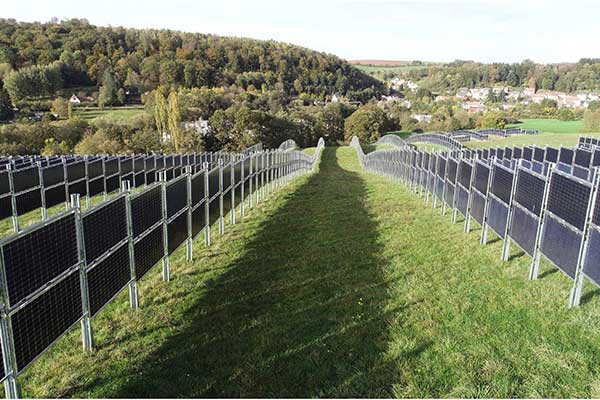- In the Northern hemisphere, solar panels are usually installed facing south with an inclination of 20 to 35 degrees to achieve maximum energy yield.
- If these modules continue to be installed primarily in a southern orientation, then in the future, additional electricity storage systems will be needed to compensate for fluctuations depending on the day and season.
- In a new study, a research team shows that it would make sense to primarily install bifacial solar modules vertically and use the land for agriculture.
Solar energy is not subject to supply shortages, is cheap and CO2-neutral. To achieve maximum energy yield, PV power plants are usually installed facing south with an angle of inclination of 20 to 35 degrees. As a result, a lot of electricity is generated in summer as well as at midday.
In the future, renewable energies are to completely replace fossil fuels—a major challenge. If solar modules continue to be installed primarily in a southern orientation in the future, additional electricity storage systems will be needed to compensate for fluctuations depending on the day and season.
In a new study published in the journal Smart Energy, a research team from Leipzig shows that it would make sense to primarily install bifacial solar modules vertically in the future and use agricultural land for this purpose.
“Bifacial solar modules can use solar energy from both sides. Installed in an east-west orientation, most electricity is generated in the morning and evening. This would reduce the need for electricity storage while at the same time minimizing the amount of land required for electricity generation,” says Sophia Reker of Leipzig University of Applied Sciences (HTWK Leipzig) and lead author of the study “Integration of vertical solar power plants into a future German energy system.”
The researchers base their argument on a simulation of the German energy system using the EnergyPLAN software.
New legislative package to accelerate the expansion of renewable energies
In order to become independent of energy imports and reduce CO2 emissions, the German parliament passed a comprehensive legislative package at the beginning of July to accelerate the expansion of renewable energies in Germany.
According to the legislation, the share of renewable energies in total electricity consumption is to be increased from just under 50% at present to 80% by 2030. Among other things, the regulatory framework for new PV power plants is to be improved in order to achieve the target.
“Bifacial solar modules are more expensive than conventional solar systems. But because they increase the number of hours of available solar energy, other electricity needs, such as in gas-fired power plants, are reduced. Installed vertically, PV power plants can be well-sited on agricultural land. This creates additional income opportunities for farmers and increases the land potential for renewable energy in Germany to such an extent that we would only need to import a small amount of additional energy,” says Jens Schneider, Professor of Interconnected Energy Systems at HTWK Leipzig and co-author of the study.
PV power plants installed on agricultural land can support the growth of certain crops by protecting plants from wind and heat. Flowering strips for more biodiversity are possible directly under the modules. The German government’s new legislative package will increase incentives for so-called agri-photovoltaics in the future.
Modelling the energy system in 2030 as a basis
For their study, Sophia Reker, Jens Schneider and Christoph Gerhards used EnergyPLAN as a software to model an energy system for Germany that, in line with Germany’s climate protection targets, would produce 80 percent lower CO2 emissions in 2030 compared to 1990.
To achieve this, the researchers assume an increase from the current 64 to 195 gigawatts of wind power and from the current 58 to 400 gigawatts of solar power. To be able to actually use this installed capacity, electricity storage facilities are needed.
In their study, the researchers show that the need for electricity storage decreases if the majority of photovoltaic capacity added is installed vertically in an east-west orientation. For example, in a scenario without additional electricity storage, more than 10 megatons of CO2 per year can be saved simply by installing 70–90% of the added solar modules vertically in an east-west orientation rather than tilted to the south.
—
Publication Referenced in the Article:
Sophia Reker et al, Integration of vertical solar power plants into a future German energy system, Smart Energy (2022). DOI: 10.1016/j.segy.2022.100083n.
—
This article was written by Rebecca Schweier, Hochschule für Technik, Wirtschaft und Kultur Leipzig.










Comments